Contents
Market Overview
Macro Review – Elections, Sanctions and Improving Data
A catalog of risk events offered ample volatility for risk/reward plays in EM this week, while core rates drove returns higher. Japanese investors bought $15.6bn in U.S. Treasuries this week as Chinese holdings rose to a 21-month high, where both offered a positive technical backdrop as rates tightened 4-8 bps. Data releases via the Empire Manufacturing expanded at its fastest pace since 2017 and initial jobless claims declined to the lowest level since March 2020, as the U.S. economic outlook brightens. Risk markets continued to see volatility decline, commodities resurge and U.S. bank earnings impress. Within EM, a favorable election outcome in Ecuador saw bonds rally 18 pts, Ukrainian tensions with Russia increased but cooled on U.S. sanctions and the positive data releases in the U.S. extended to China with GDP, industrial production and retail sales. Nevertheless, concerns that the credit impulse has peaked comes with M2 dipping below 10% in March, just as the Li-Keqiang Index increasingly appears to be in bubble territory. Despite growing event risk, the IG segment of the market was well bid and a growing new issuance pipeline is emerging, just as Tencent issued $4.15bn with books as high as $22bn. On top of that, we note inflows into EM credit, which now stand at $2.4bn in April already.
EM Credit Update
EM credit ended the week up 1.2% with spreads 4 bps tighter. Approximately 85 bps of the weekly figure was driven by U.S. Treasuries, which lifted the weekly return figure to the highest level since mid-November. At the sovereign-level, Ecuador, Zambia and Sri Lanka outperformed, while Suriname, Romania and India lagged. EM local currency funds, measured by the GBI-EM Global Diversified Index, posted its second consecutive weekly return that was higher than 1%. The Index has not strung two consecutive up weeks of that magnitude since July 2020.
The Week Ahead
The focus of next week is likely on the ECB and Eurozone flash PMIs as we extend into the second week of U.S. earnings. Meanwhile, the EU and the U.S. are set to continue reviewing J&J and AstraZeneca after further concerns around blood clots. Within EM, rate decisions out of China (3.85%), Indonesia (3.5%), Israel (0.1%) and Russia (4.5%) stand out. We will also see inflation releases out of Hong Kong, Malaysia, Mexico and South Africa. Most of the focus in Latin America rests on trade data in Colombia, growth in Brazil, and employment in Mexico.
This week’s emerging markets highlights discussed below include: New U.S. sanctions on Russia, the rates decision from the Central Bank of Turkey, Guillermo Lasso’s victory in Ecuador’s presidential election and Peru’s first round of presidential elections.
Fixed Income
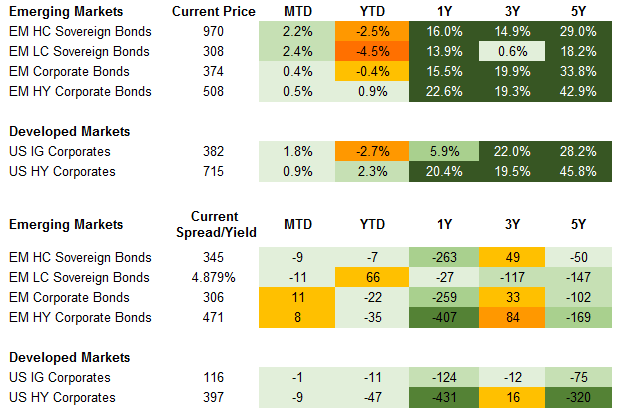
Equities
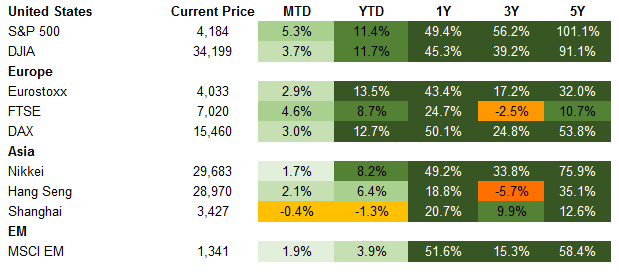
Commodities

Source for data tables: Bloomberg, JPMorgan, Gramercy. EM Fixed Income is represented by the following JPMorgan Indicies: EMBI Global, GBI-EM Global Diversified, CEMBI Broad Diversified and CEMBI Broad High Yield. DM Fixed Income is represented by the JPMorgan JULI Total Return Index and Domestic High Yield Index. Fixed Income, Equity and Commodity data is as of April 16, 2021 (Mid Afternoon).
Emerging Markets Weekly Highlights
New U.S. sanctions on Russia send a clear warning signal, but keep the door open for a geopolitical reset and are likely to have limited economic/market impact
Event: U.S. President Biden signed an Executive Order on April 15 imposing a variety of sanctions on Russian persons and entities in response to alleged election interference and malicious cyber activity. Biden’s Executive Order prohibits U.S. financial institutions from participating in the primary market for RUB denominated bonds after June 14, 2021, which builds upon similar measures imposed for non-RUB debt back in 2019. The order does not prohibit any secondary market activities. The new round of sanctions comes on the heels of a direct call between Biden and Putin earlier this week that seems to have set the stage for a summit between the two presidents in the coming months.
Gramercy Commentary: The new U.S. sanctions on Russia announced this week undoubtedly include significant measures, however, they fall short of using any “nuclear options” such as bans on secondary trading and/or targeting major sectors of the Russian economy. As such, we believe the sanctions have been designed with two main objectives. First, they should be seen as a relatively low intensity “warning shot” to the Kremlin, while clearly signaling willingness to ramp up pressure in the future in case of potential resumption of hostile behavior. Second, the sanctions are also aimed at satisfying strong domestic political appetite and bi-partisan pressure in Congress to “punish” Moscow for election meddling and other offensive cyber activity blamed on Russian actors. Markets have reacted with understandable concern to the latest developments, but we think Russian assets should be able to absorb the impact relatively unscathed, supported by Russia’s extraordinarily strong sovereign credit fundamentals and macroeconomic profile. In addition, we believe a more constructive narrative might start to emerge once the dust settles. With decreased uncertainty around sanctions and potential for lower noise on this issue in U.S. domestic politics, at least in the near-term, markets should be able to price more accurately geopolitical risk premium in Russian assets going forward. Both sides have expressed a desire to start repairing the bi-lateral relationship and investors’ focus might start to shift to areas of potential cooperation between the White House and Kremlin, such as climate change, nuclear proliferation and relations with China. This will be especially true in the case the proposed summit between Presidents Biden and Putin becomes a reality in the not-so-distant future and the recent tensions at the Russian-Ukrainian borders ease.
The Central Bank of Turkey (CBRT) held rates at 19%, but removed hawkish bias from forward guidance, exposing Turkish assets to domestic inflation dynamics and global risk sentiment
Event: The CBRT kept its main policy rate at 19% at the first monetary policy meeting under new Governor Kavcioglu, but removed from its forward guidance a language reference to “tighter monetary policy if needed”.
Gramercy commentary: The CBRT eliminating the hawkish bias from its monetary policy forward guidance is a critical signal for markets, in our view. Keeping the policy rate on hold at 19% and committing to maintaining a positive onshore real interest rate is positive relative to what would have been a worst-case scenario of delivering pre-mature policy easing at the April meeting. However, we worry that without the option of further monetary tightening (seemingly ruled out by the CBRT at this stage), the TRY and Turkish assets in general will be left completely at the mercy of domestic inflation dynamics and global macro developments. Both have turned more challenging since the start of the year. The latest statement by the CBRT is a clear signal to us that unless headline inflation surpasses 19% y-o-y and onshore real interest rates drop back into negative territory, the new CBRT leadership team will not tighten policy, given political constraints on higher interest rates. This is a bad backdrop for TRY and not a great one for Turkish risk in general. With recent TRY weakness on the back of former Governor Agbal’s abrupt firing in late March, we would not be surprised to see headline inflation pushing toward a 18-18.5% range in the coming months, double the CBRT’s current year-end target of 9.4% y-o-y. Unanchored inflation dynamics and the authorities’ reluctance to increase rates proactively going forward has the potential to put the CBRT and Turkish assets in another “make it or break it moment” in the near future, in our view.
Guillermo Lasso’s victory in Ecuador’s presidential election materially improves outlook for economic policy and IMF cooperation
Event: To the delight of markets, Guillermo Lasso, a center-right former banker, won Ecuador’s presidency against the odds, defeating leftist Correista candidate Andres Arauz in last Sunday’s runoff. Lasso managed to overcome a 13-percentage point deficit from the first round.
Gramercy commentary: A market-friendly outcome in Ecuador’s presidential elections was not priced in, which led to a massive rally in the sovereign Eurobonds complex this week. It reflects investors’ relief that, despite the acute economic and health crisis due to the pandemic, Ecuadorian voters rejected a potential return to populist economic policies associated with former President Rafael Correa that could have threatened Dollarization, Ecuador’s most popular institution. An orthodox approach to economic policymaking under Lasso means that the fragile Ecuadorian economy is likely to continue on its path of fiscal and external adjustment initiated by the outgoing Moreno Administration. Importantly, a Lasso presidency bodes well for the critical relationship with the IMF and securing multilateral financing. With the main political risk for markets out of the way now, the focus will shift to the Lasso Administration’s ability to govern and deliver on reforms/IMF conditionality given the complex and fragmented composition of the National Assembly. Lasso’s own party CREO and their center-right Social Christian Party (PSC) allies control just 31 of 137 seats in parliament. They will need support from the 45-member coalition of leftist Pachakutik (PK) and center-left Izquierda Democratica (ID) for any legislation initiatives, including on the IMF program. Despite the complex domestic political environment, we expect President-elect Lasso to enjoy a “honeymoon period” for the rest of 2021, also benefiting from macro headwinds such as higher oil prices, and, eventually, getting the pandemic under control.
Peru’s first round presidential election outcome points to ongoing political headwinds
Event: The presidential vote held on Sunday resulted in a first place victory of radical leftist candidate Pedro Castillo (19%) followed by market friendly, albeit corruption tainted, Keiko Fujimori (13%) in second place. Rightest businessman Rafael López Aliaga and center-right economist and politician Hernando de Soto followed closely in third and fourth place with around 11.5% of support. Congressional results were fragmented with at least 10 parties gaining representation including Castillo’s Peru Libre with roughly 17% and Fujimori’s Fuerza Popular with 18% of seats. A run-off race between Castillo and Fujimori will be held on June 6.
Gramercy Commentary: We anticipated late evolution of voter preferences and room for the emergence of an outsider populist candidate given the high degree of voter uncertainty, high number of candidates, and distrust of the political class in the backdrop of the significant social challenges linked to the ongoing health crisis. The results suggest governability challenges and political noise will likely persist regardless of the ultimate outcome, thanks to a divided and relatively unexperienced congress with continued pressure for populist policies. In the case of a Fujimori victory, policy continuity at the macro and micro level should broadly be maintained, but stability risks will stem from her ongoing corruption charges and high disapproval rates, fueling polarization and complicating policymaking. Absent moderation, a Castillo presidency would likely threaten Peru’s broader credit profile and approach to macroeconomic policy given prospects for nationalizations, contract revisions, and rewriting of the constitution. We continue to expect lackluster sovereign bond and FX performance as a result of political headwinds and associated policies albeit the robust external backdrop combined with copper price appreciation may cap weakness and help support a temporary rebound in the case of a Fujimori win.
Emerging Markets Technicals
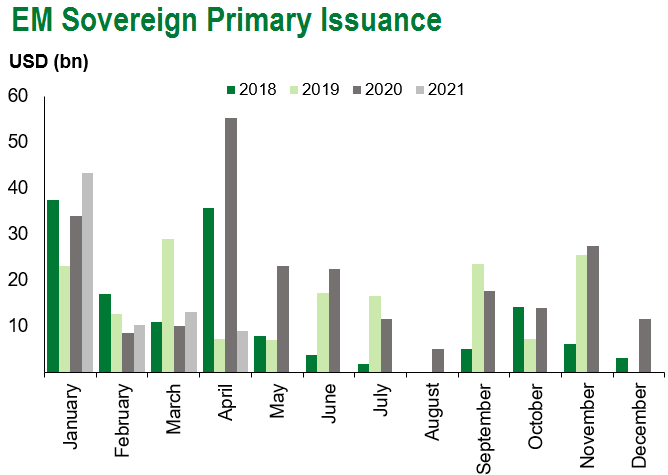
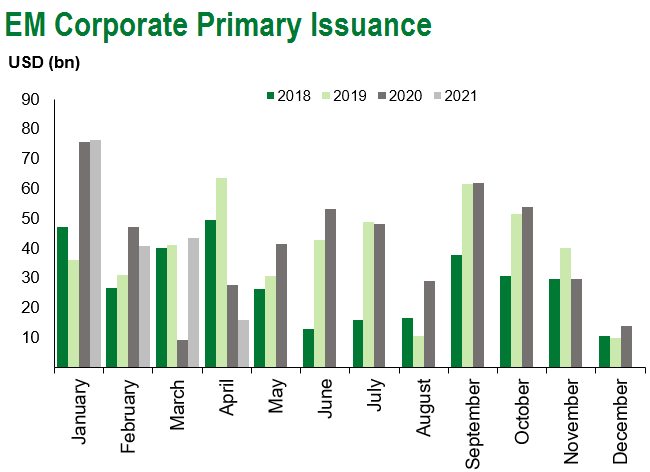
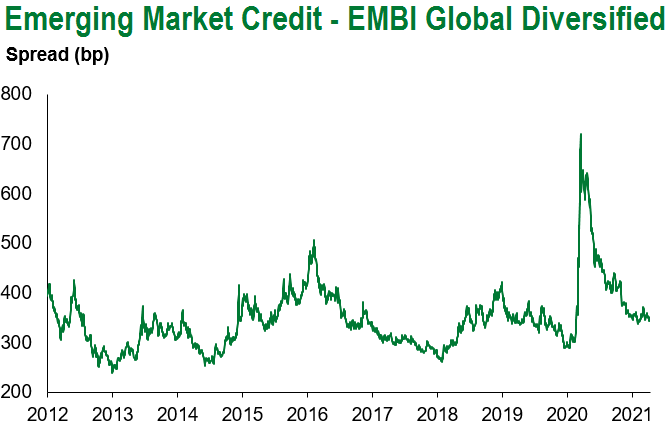
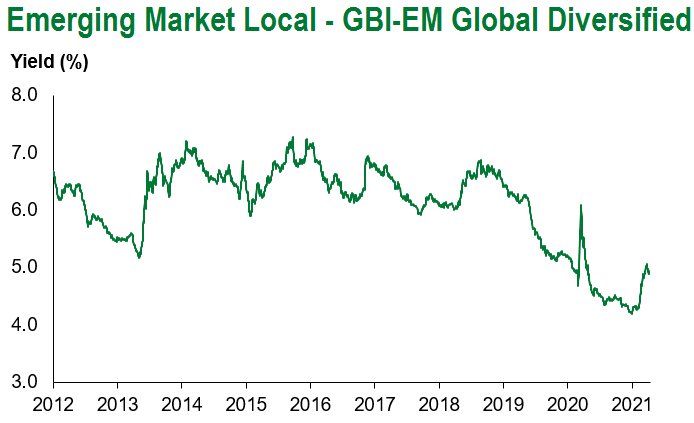
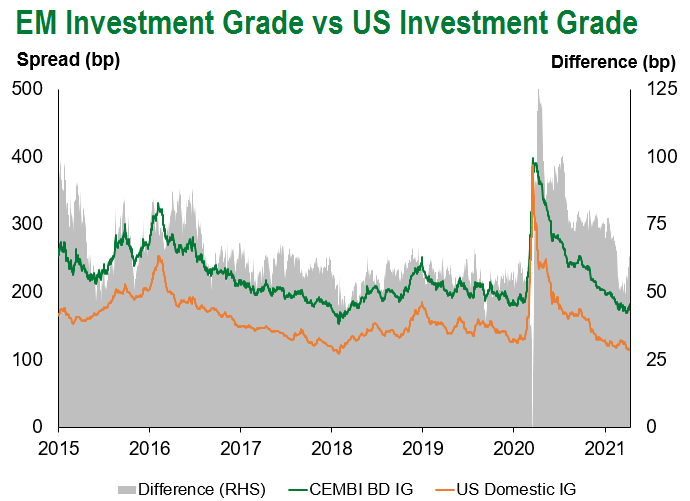
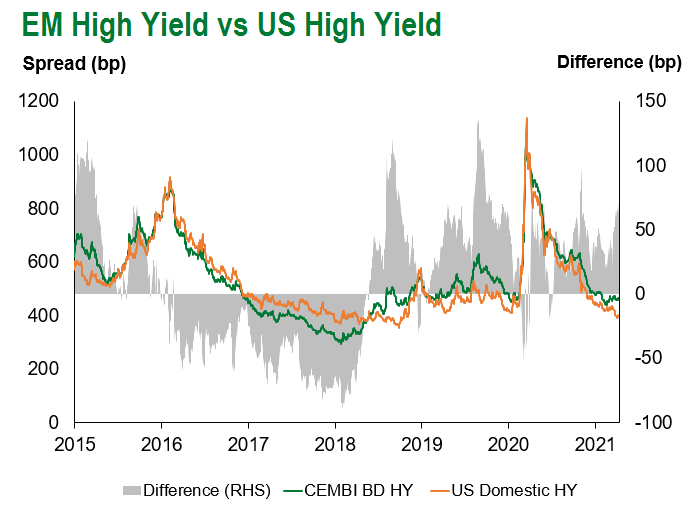
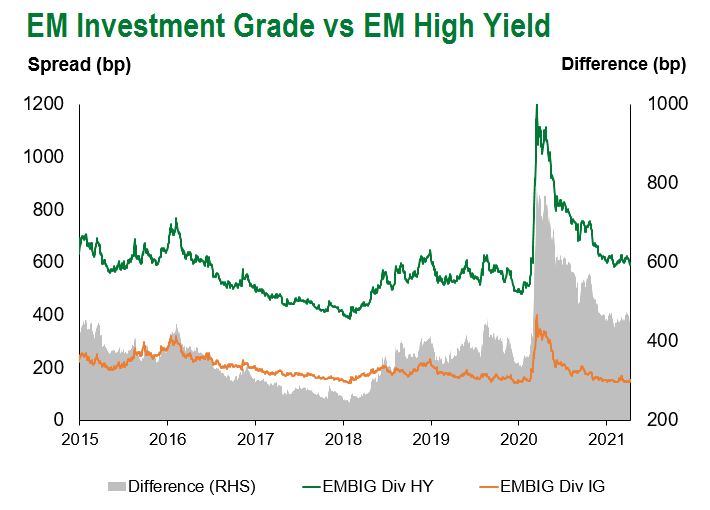
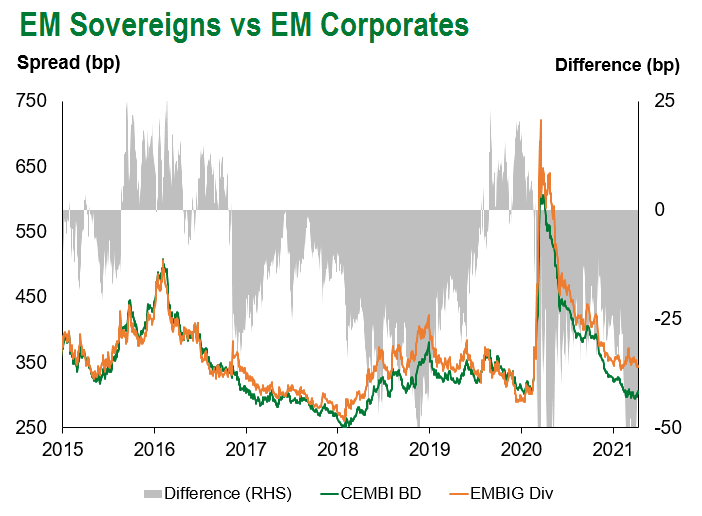
Emerging Markets Flows
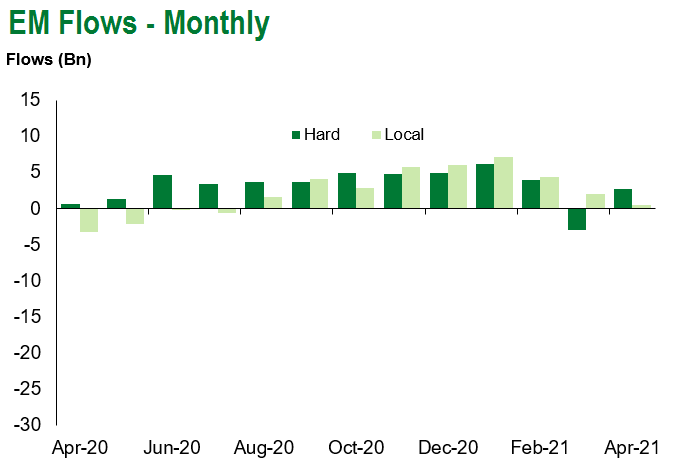
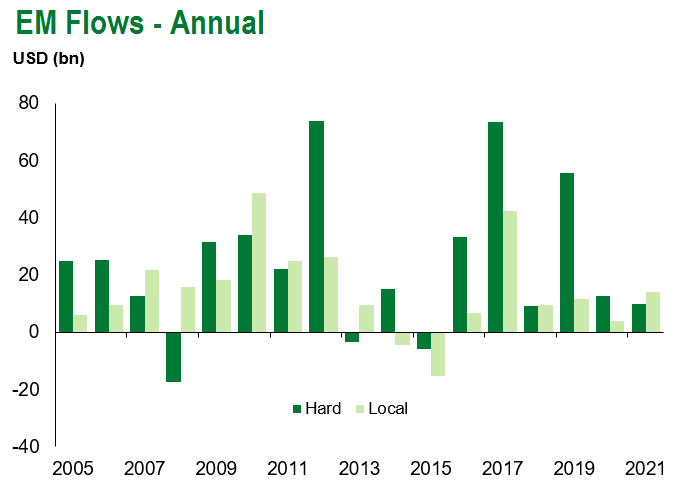
Source for graphs: Bloomberg, JPMorgan, Gramercy. As of April 16, 2021.
COVID Resources
Emerging Markets COVID-19 Case Summary
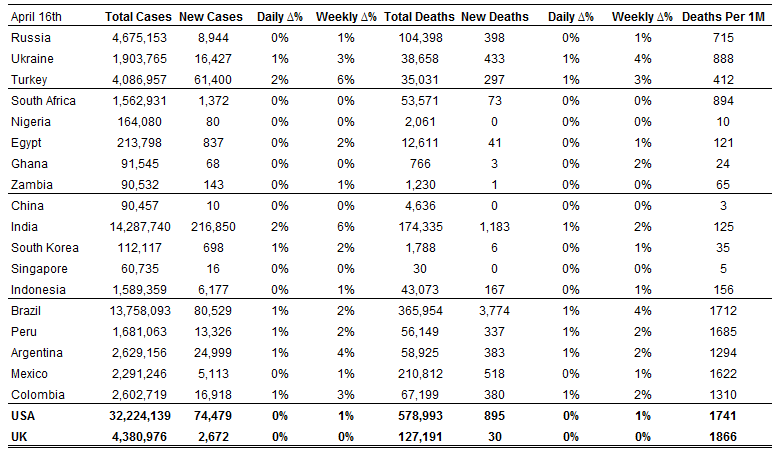
Source: Worldometer as of April 16, 2021.
Additional Crisis Resources:
Johns Hopkins COVID-19 Case Tracker
For questions, please contact:
Kathryn Exum, Senior Vice President, Sovereign Research Analyst, [email protected]
Petar Atanasov, Senior Vice President, Sovereign Research Analyst, [email protected]
Tolu Alamutu, CFA, Senior Vice President, Corporate Research Analyst, [email protected]
James Barry, Vice President, Corporate Research Analyst, [email protected]
This document is for informational purposes only. The information presented is not intended to be relied upon as a forecast, research or investment advice, and is not a recommendation, offer or solicitation to buy or sell any securities or to adopt any investment strategy. Gramercy may have current investment positions in the securities or sovereigns mentioned above. The information and opinions contained in this paper are as of the date of initial publication, derived from proprietary and nonproprietary sources deemed by Gramercy to be reliable, are not necessarily all-inclusive and are not guaranteed as to accuracy. This paper may contain “forward-looking” information that is not purely historical in nature. Such information may include, among other things, projections and forecasts. There is no guarantee that any forecasts made will come to pass. Reliance upon information in this paper is at the sole discretion of the reader. You should not rely on this presentation as the basis upon which to make an investment decision. Investment involves risk. There can be no assurance that investment objectives will be achieved. Investors must be prepared to bear the risk of a total loss of their investment. These risks are often heightened for investments in emerging/developing markets or smaller capital markets. International investing involves risks, including risks related to foreign currency, limited liquidity, less government regulation, and the possibility of substantial volatility due to adverse political, economic or other developments. The information provided herein is neither tax nor legal advice. Investors should speak to their tax professional for specific information regarding their tax situation.